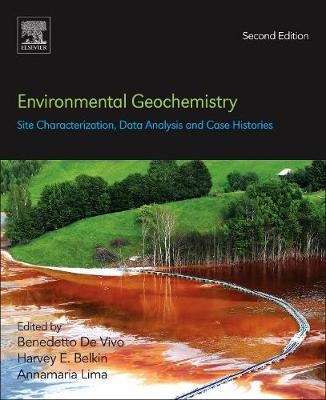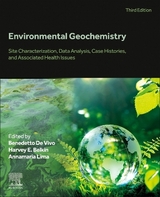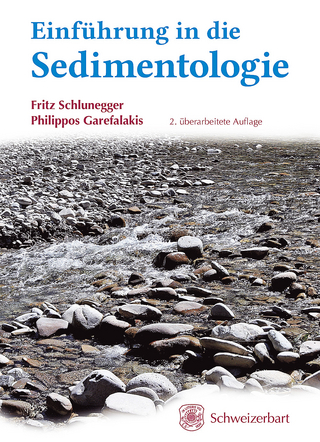
Environmental Geochemistry
Elsevier Science Ltd (Verlag)
978-0-444-63763-5 (ISBN)
- Titel erscheint in neuer Auflage
- Artikel merken
Benedetto De Vivo, after graduation (1971) from the University of Naples Federico II in Geological Sciences and military service (1972), worked for private companies operating in Italy, Africa, and Central America in the field of ore deposits, geochemical prospecting, environmental geology, and hydrogeology (1973–1977). Later, he was a Researcher at CNR-Roma, Italy (1977–1987), Associate Professor in Applied Geochemistry (1987–2000), and Full Professor in Geochemistry at the University of Napoli Federico II (2000–2017). He was a research fellow at the Colorado School of Mines (1978) and at US Geological Survey, Reston, VA (1982 and 1992); Chairman of the Working Group “Inclusions in Minerals of the International Mineralogical Association; Member of the Editorial Board of GEEA (2004–2007), Minerology and Petrol (1997–2007), American Mineralogist, and Chief Editor of Journal of Geochemical Exploration (2007–2017). His research interests span a wide range of topics including geochemical prospecting, fluid and melt inclusions studies on volcanic and sub-volcanic systems, and environmental geochemistry. He has published about 300 papers (in top international peer-reviewed journals), editing different special volumes (Journal of Volcanology and Geothermal Research, European Journal of Mineralogy, Institution of Mining and Metallurgy, and, Minerology and Petrol), and has authored four text books (in Italian) in geochemical prospecting and environmental geochemistry. He was nominated (2001) as Fellow of the Mineralogical Society of America and appointed as an Adjunct Professor at Virginia Tech, Blacksburg, VA, USA (2006), Nanjing University, China (2016), and Hubei Polytechnic University, Huansgshi, China (2019). He was the recipient of the 2019 Gold Medal Award of the Association of Applied Geochemists for outstanding scientific contributions and achievement in applied geochemistry. Harvey Belkin is currently a Research Geologist Emeritus for the U.S. Geological Survey, Reston, Virginia. After a career of 45 years, the position of Emeritus allows continued research. After majoring in geology and geochemistry at Franklin and Marshall College and George Washington University, he joined the Branch of Experimental Mineralogy and Geochemistry, USGS. During the early part of his career, he applied the study of aqueous and silicate-melt inclusions to address problems in a wide variety of earth environments, such as ore deposits, radioactive waste disposal, and volcanology. The latter part of this career involved human health issues related to domestic use of coal and other earth materials as well as continued research in different aspects of mineralogy, petrology, geochemistry, and volcanology. The author or co-author of more than 150 peer-reviewed papers, more than 200 presentations, and editor or co-editor more than 20 books and abstract volumes, Harvey Belkin continues research in a wide variety of geologic problems. Since 1997, she is an Associate Professor in Geochemical Exploration and Environmental Geochemistry. Her research includes environmental geochemistry for the evaluation of anthropogenic pollution, site characterization and remediation. Data processing techniques (classical and non-parametric statistical methods, factor analysis, etc.), including geo-statistics and plotting of geochemical distribution maps. Fluid and melt inclusions in minerals applied to ore deposit genesis, geothermometry, magma genesis, and volcanology. Geochemical exploration applied to natural resources and for evaluation of the environmental hazards related to their exploitation. On the latter topics she published about 400 papers, mostly in international peer reviewed journals, 21 Monographs, 7 Editor Special Volumes (as Editor), 2 textbooks, 8 Educational Publications, 56 extended abstracts.
Preface METHODS AND PROCEDURES 1. Field methods in regional geochemical surveys 2. Sampling methods for site characterization 3. Contaminated groundwater sampling and quality control of water analyses 4. The collection of drainage samples for environmental analyses from active stream channels 5. Biological monitoring for environmental chemical risk assessment 6. Data conditioning of environmental geochemical data: Quality control procedures used in the British Geological Survey’s regional geochemical mapping project 7. Gas chromatographic methods of chemical analysis of organics and their quality control 8. Evaluation of geochemical background at regional and local scale by fractal filtering technique: Case studies in selected Italian areas 9. Geochemical mapping of urban areas 10. Chemical speciation to assess bio-availability, bio-accessibility and geochemical forms of potentially toxic metals (PTMs) in polluted soils 11. Extraction and characterization of pore water in contaminated soils 12. Models of geochemical speciation: structure and applications POLLUTION AND CONTAMINATION 13. Lead and strontium isotopes as monitors of anthropogenic contaminants in the surficial environment 14. Preliminary Pb isotopic compositions of soil profiles near lead smelters, East Los Angeles, California, U.S.A. 15. Polyurethane foam-based passive air samplers in monitoring persistent organic pollutants: theory and applications 16. Legacies of Organochlorine pesticides (OCP) in soil of China – A review, and cases in Southwest and Southeast China 17. The Bagnoli-Napoli brownfield site in Italy: before and after the remediation ASSOCIATED HEALTH ISSUES 18. Potential contaminants, and sustainable HazMat infrastructure: Neodeterministic (NDSHA) approach guarantees prevention rather than cure. The Bophal - Madhya Pradesh, India - gas tragedy case 19. Application of geochemistry to medical geology 20. Environmental human health issues related to indoor air pollution from domestic biomass use in rural China. A review 21. Properties, utilization, and potential health and environmental issues of depleted uranium (DU) for military and civilian use 22. Biological, chemical, and environmental hazard of desert dust to military personnel 23. Indoor mercury pollution in the herbaria: risk assessment for workers’ health and potential solutions. The studies at the Florence (Italy) herbaria. 24. Occurrence and Risk Assessment of Organochlorine Pesticides (OCPs) in Multimedia Environment from Zigui Karst Area, China
| Erscheinungsdatum | 30.09.2017 |
|---|---|
| Verlagsort | Oxford |
| Sprache | englisch |
| Maße | 191 x 235 mm |
| Gewicht | 1330 g |
| Themenwelt | Naturwissenschaften ► Geowissenschaften ► Geologie |
| ISBN-10 | 0-444-63763-X / 044463763X |
| ISBN-13 | 978-0-444-63763-5 / 9780444637635 |
| Zustand | Neuware |
| Haben Sie eine Frage zum Produkt? |
aus dem Bereich



